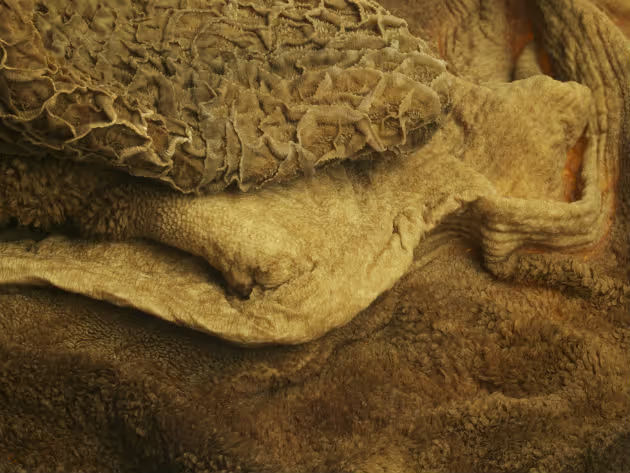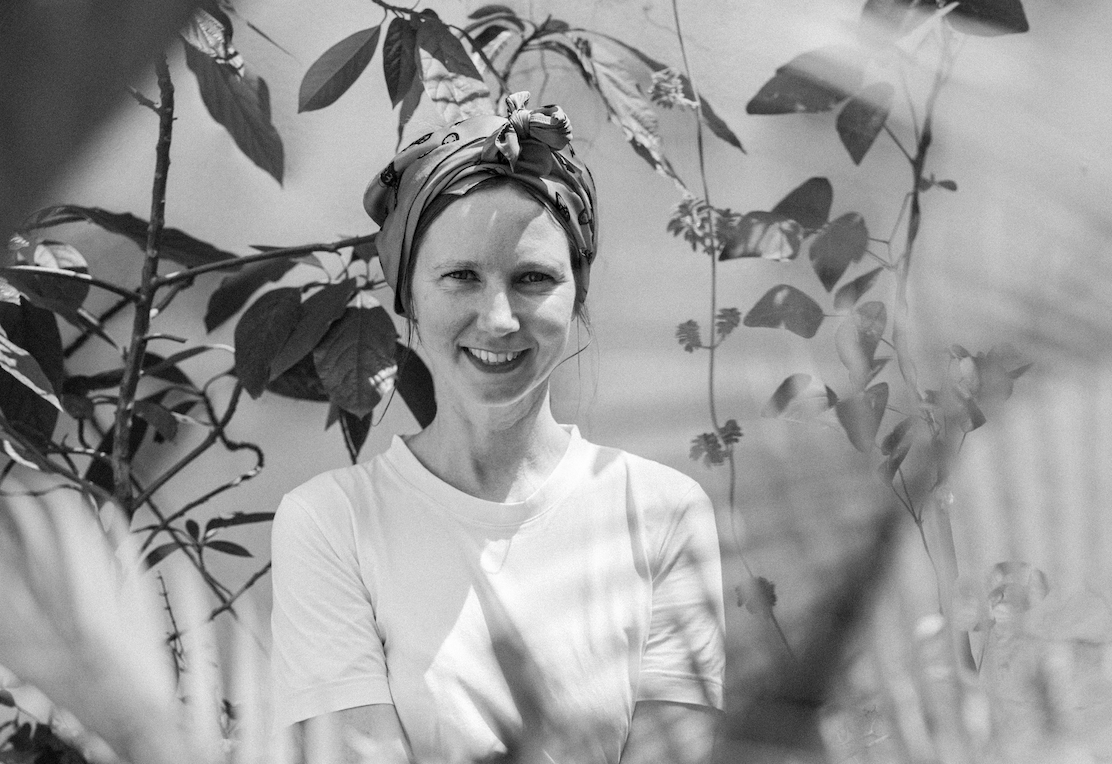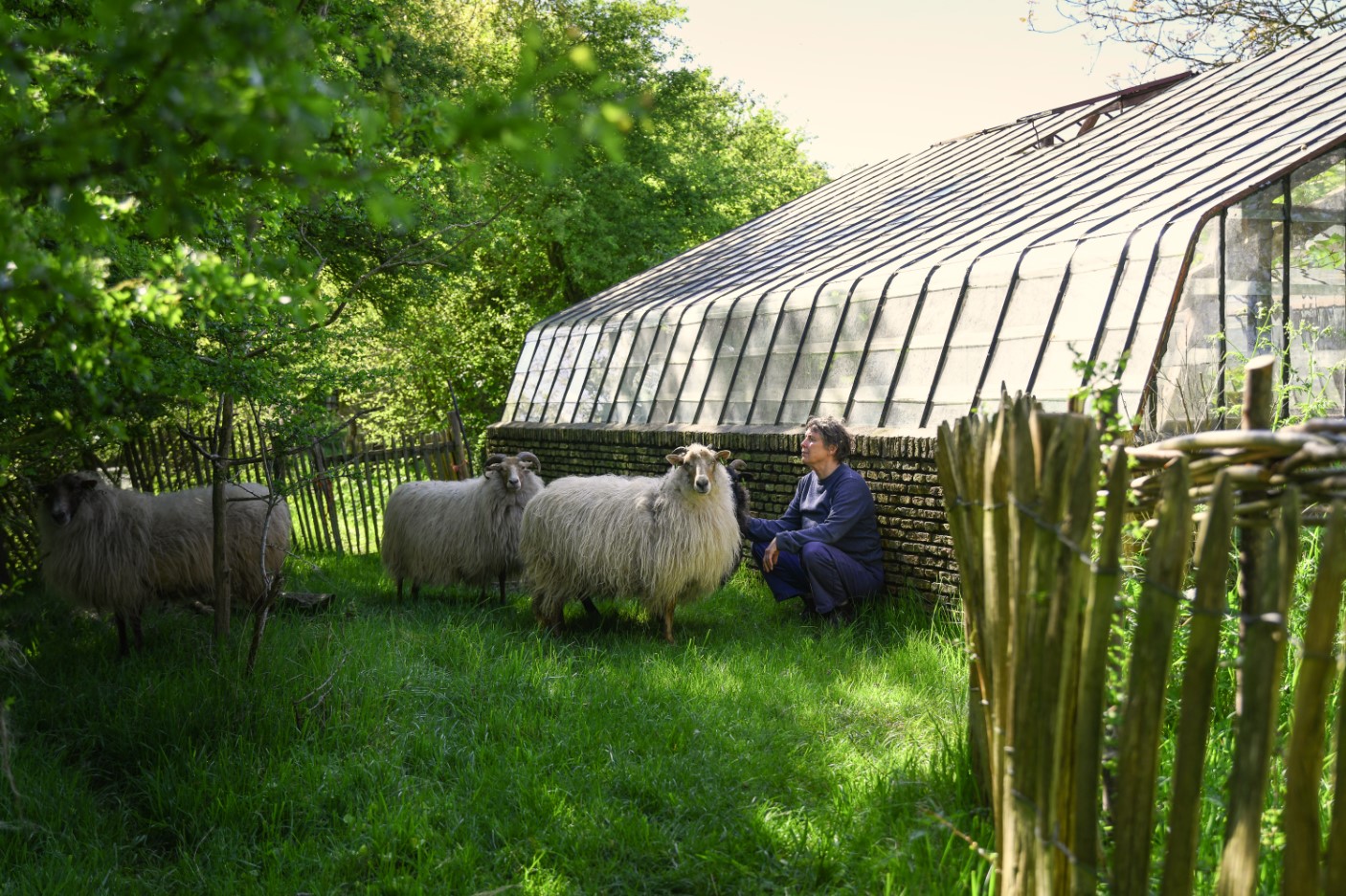Where to begin?
At the beginning...
Is it correct to say that the first unusual material with which you worked was seaweed?
Precisely. Back at the academy we were working on an environmental project. The idea was to design a beach house – and that is when I began working with seaweed. I noticed that this material was translucent, and was fascinated by how it could change colours. It was wonderful. Because I was oriented towards product design at the time, I immediately had the idea of making a vase from this algae – to be able to pour water into a container made of this material. When I sent it to the Material ConneXion materials library in New York, it was incredible because it ended up leading to an article in Forbes magazine. It was just a fortunate thing that the very first art object I made during my studies ended up making waves around the world.
Which must have come as a surprise.
Certainly.
Did you then continue to work with algae or similar types of organisms?
No, I then shifted to leathers and fine arts. The algae project continued making the rounds of exhibitions, for example in Vincenza. But I didn’t make any more objects from this substance.
Was it easy working with such a material?
No. It was difficult. Making the substance fit into a form, and for the pieces to fit with each other, was hard. I find it far easier to use materials in a way they corresponds to its natural shape. I hold such materials in my hand and then think about the best possible shape, and the best way to combine the pieces together. With algae, one of the problems arose during rainfall – it would begin to soak up water, and then it would shrivel again. It took me a year to figure out how to stabilise it to a degree.
Perhaps there are better materials from which to make vases...
Absolutely.
In recent years, you have been working with the digestive tracts of various animals. Might it be possible to make some kind of vase from a stomach organ?
Probably, but let me again return to my studies: I began to doubt whether I should even be creating some kind of end product with my works. That was certainly expected of me as a product design student. But when I held wonderful materials in my hand, and changed their form, cut down edges which were themselves inherently beautiful, then I started to wonder about whether it might be better to focus on the material itself rather than to try to make it into something else.
Do you believe that such efforts were part of an overall trend in the world of materials-oriented design?
This was around 2008. I later discovered that there are many others who have a deeper interest in materials development. Presently I am oriented towards fine arts. I am not a designer. I see materials, and appreciate their qualities and beauty. I seek to highlight natural beauty.
Does your approach often overlap with the strategies utilised by product designers and companies?
I think so. It is crucial to monitor the source and quality of materials. If, for example, I want to make a spoon, rather than immediately thinking about what material to use, I look around and see if there are some kind of natural formations and structures which already resemble the shape of a spoon.
Do you know of any product designers embarking on the route you just described? Isn’t it more of a dream than reality?
I suppose I don’t know any who work that way.
On the other hand, you have been approached by major firms such as Adidas and New Balance expressing an interest in your stomach-based leathers.
Yes, they acquired samples of these leathers and were interested in the quality of the material. But on the other hand, materials such as a cow’s stomach hardly comes in a perfectly straight form - it has a specific shape. Which is another reason why I shifted towards fine arts. If something is rounded, then you can stretch it, but it is obvious that this is not the natural form of the material. So if we force leathers to take on a different shape, then they cease to look as appealing. Because we are changing their inherent character.

Have you then decided to not force materials to do anything unnatural?
Yes, I don’t want to be forcing anyone to do anything that they do not want to do.
That is surely a good thing for the people and materials around you! How long did it take you to learn to work with and process leathers?
Years. I began ten years ago, and then a few years ago the quality was finally good enough for the leathers to be utilised, for example, in fashion.
When working with stomachs and other animal organs do you use any potentially dangerous chemicals?
No – a company has developed liquids for this purpose that don’t damage the environment.
Where do you actually work? Can such work be undertaken in an urban environment?
I began doing this at the art academy. I first set up a tannery full of large vats in my parents’ garden. Later, after gaining my grant funds, I began working with smaller established tanneries.
Where did you obtain your stomachs?
At first I would visit small slaughterhouses and the local butcher near the family home. But soon that wasn’t enough, as they only slaughtered a few pigs and occasionally a cow every so often. And so I started hopping over the border into France. The advantage of this was that I was able to obtain far cleaner stomachs. Previously cleaning out animal organs, including removing fat, would take considerable time. And the material is very fragile and so it must be done carefully.

Cleaning (Photo credit: ©Mandy Den Elzen)

And you carry out the washing of the organs yourself?
Yes. I can’t find anyone else who would want to do it. It is very...
Dirty work? So you function without an assistant.
Yes. And whenever I do it I sort of feel sorry for myself, and wonder why I am doing this and not something cleaner like drawing. But when it is done then I am back to knowing it was worth the effort. It looks amazing. And then when a company like Nike or Fendi ask for samples then I am pleased that they too see the inherent beauty in something like a cow’s stomach.
Do you view this material as being environmentally sustainable? Or do you avoid concepts like that?
I don’t use that term. But when my works are on display then the exhibitions are frequently the kind that are associated with sustainability, nature, organic art and so on. But it certainly isn’t one-hundred percent sustainable. If something is natural, then it should be biodegradable. But the way I process it ensures that it endures. On the other hand, I don’t use harmful materials. As for the resources – there are tonnes of animal stomachs available; some get eaten, but certainly not all.
What is your view with regards to the mass production of meat? Today this is something of a hot topic.
I have an interest as to where animals come from, and specifically that they do not come from industrial rearing facilities. And the abattoirs from which I source my internal organs treat the animals as humanely as possible. On the other hand, they still slaughter them. It is complicated, and I am aware of the dissonance.
Perhaps it would be interesting to display the stomach of an “unhappy cow” alongside one which has lived in the best possible conditions. People could compare the two...
You would see the difference, mainly in colouration. I noticed it when I sourced stomachs from small slaughterhouses near the village where I lived. The stomachs looked different than those coming from factory farms. Internal organs reveal how the animals have lived.
You have recently begun working with ostrich stomachs. How did you obtain them?
They came from a farm where ostriches are reared for their eggs and meat. Which means their stomachs were truly considered waste items.
Naturally – surely no one has ever tried to make a soup from an ostrich stomach! Are they expensive?
I always buy the materials, I believe they are overpriced. And materials as ostrich stomach they price highly. They are not easy to find. By the way before setting out somewhere I send the supplier an email that I am on my way. And when I arrive they are often surprised that a person like me could work with such a type of material.

Preserved ostrich stomach (Photo credit: ©Mandy Den Elzen)
And when heading out to purchase stomachs, how many do you usually buy?
Hundreds.
So you take the car and drive from southern Holland to France; you then return with hundreds of stomachs and put them in your fridge?
I pull down the seats in my work car and fill it with plastic containers. I then hope no accident occurs that would cause the parts to splat over me! I transport the stomachs to the tannery, where I unpack them, cut out the fat, and begin the tanning process, which takes around two weeks. After that I leave them to dry for several weeks.
When the resulting objet d’art go on display are visitors permitted to touch them?
Sometimes. Some museums contact me precisely seeking the opportunity for visitors to physically interact with the kinds of organs that are usually only accessible through liquid-filled jars. When the stomachs are on display, everyone wants to touch them, as they look somewhat similar to corals. Some people first say how beautiful these objects are, but when they find out what they really are, then they go into shock and their reactions change. That is a little odd, as the material which they previously enjoyed is still the same.
So emotional reactions play a role.
Yes. But what has changed exactly? Social and cultural norms tell us that a cow’s stomach cannot be beautiful.
Could you imagine yourself working with human body parts? Or does that cross a line for you?
Yes, that would cross a line... I once spent a day in a slaughterhouse watching pigs getting slaughtered. And I saw that their heads had the same skin colour as me.
There are clearly certain similarities...
Yes, although pigs usually don’t consume human beings.
We hope not! What was your overall impression of the slaughterhouse?
When you see it, then it is hard to eat meat afterwards. You realise that these are living creatures. As soon as you look an animal in the eyes, then you form a kind of connection with it. And that is very different from simply buying meat in a supermarket, where it is neatly packaged in plastic and labelled. You have no sense of the back-story.
And the way it looks is surely one of the decisive factors...
Indeed. The key is to realise the true origins of things. To treat living beings and the natural world with respect. At exhibitions of my works, I underscore that stomachs can be both ugly and beautiful… We shouldn’t have predefined scales to determine what is or is not normal – after all, it all derives from nature.
Perhaps you are trying to expand the scope of what is perceived as normal.
I believe so. Our perceptions are significantly shaped by our culture. For example, when travelling in India you will see that it is entirely normal to build walls from animal poo. But you won’t see anything like that in Holland.
What is your opinion of synthetic materials?
That is a difficult question, as much depends on its intended use. I personally prefer natural materials; I find them more appealing. I also don’t like imitations, for example plastic designed to look and feel like something else. On the other hand, I cannot imagine that I might have something like a laptop made of wood – that would probably not work too well!

Fish gills (Photo credit: ©Mandy Den Elzen)
You have also started working with fish organs. How did you arrive at this new direction?
I came across some fish at a market. It was a slightly silver fish, similar to a mackerel, but with unusual features on its head. I was interested to learn how it might look on the inside, and how it works. When I dissected it, I came across the fish’s gills. I found them to be very beautiful. And I said to myself that I will try to preserve them and to present them at a more scientifically-oriented exhibition. I spent three years working on them.
Did your experiences with animal stomachs come in handy?
In some ways, but the work was very different. I had to learn many new techniques.
What is required before such gills are desiccated and ready to be presented in a gallery?
First, I surgically separate them from the head. There is a considerable amount of slimy material and so it has to be cleaned and the blood drained. Then the preservation process begins by way of various liquids. And at the end the gills are desiccated. All of this takes about three-and-a-half weeks.
And all that time you are focusing on these organs. Don’t they enter your dreams?
No. I enjoy going cycling. When I see a rabbit or a bird, then I always think – how they look inside. But I would never kill an animal just to utilise its internal organs.
Today you are a successful artist. How did you manage to gain a sense of economic security?
Five years ago I gained a grant, thanks to which I was able to spend an entire year fully focused on my work. I didn’t have to divert my attention to any other external project. I am very grateful for the opportunity; if I hadn’t been so lucky everything would have taken far longer.
Permit me to again return to the subject of animal stomachs. What was it that you found so appealing about their structures?
Each of the four stomachs which cattle possess are different. The structures adapt to the specific function an organ must perform. The first looks bit like furry, has small papilla, the second has beehive structure. The third has a very complex structure, which is both upside down and inside out. The fourth stomach has ridges. It is interesting to follow the entire process of how fresh grass transforms into dung.

Cow stomach (Photo credit: ©Mandy Den Elzen)
Has your work influenced the way you view your own body and stomach?
Absolutely. When I work with such materials and visit slaughterhouses, then all of this has caused me to reflect more on my own being – how I appear, my own relationships with animals...
Has it helped you to better understand your own body?
Some animal parts are similar to those of humans. For example a pig’s stomach looks almost identical to our own. It is quite fascinating to hold in my hands a stomach which is similar to the one in my body.
It is quite a leap of the imagination for us to imagine our insides. Do exhibitions featuring such elemental components have more power in Western countries, where modern urban populations are more removed from traditional hands-on methodologies?
Probably. My projects have been engendering great interest for example in places like New York.
What are the commercial prices of your creations?
They are somewhat more expensive than regular commercial leather. But they are not so expensive so as to be out of reach for ordinary people. It depends on the animal I have utilised. For example, an ostrich stomach has a far more complex structure than a sheep. And so it requires far more work.
Can you recall any book, article, artist or other force which significantly affected the direction of your work?
Probably not, but I do like Aristotle. He also collected various types of plants, and created something akin to a museum of natural science.
How important for you are visualisations of your work? Specifically photographs of your artworks. Do you take such photographs yourself?
No. I have them done professionally. They form a significant component of the overall project. I try to have the process under my thumb, as it is very important that the final photographs of my works look their best.
I can imagine, given the time you spend on each work... So is the intention for such visual representations to create an impression of great beauty?
Yes, I want the pictures to be as authentic as possible. I tell the photographers that it has come from nature, and that it really is a thing of beauty. These are the insides of a cow that you might pass while cycling past a field. But no matter how well it is photographed. A digital representation can never match the beauty of reality!


Mandy Den Elzen is a Dutch artist, whose efforts are centred on revealing the hidden components of living organisms. One of her aims is to stimulate the imaginations of those who observe her works – engendering a sense of contemplation. In 2016 she gave a number of lectures as part of the “How to Survive in the Post-Digital Age” event held in the Czech city of Brno, organised by the Prague Architecture and Media Forum (Fórum pro architekturu a média). Her works have been displayed in dozens of exhibitions around the globe and form part of numerous public and private collections.
Interview conducted by Tereza Lišková; edited by Karolína Jánošíková, Dominik Jůn
Portraits: Tomáš Rubín




